2005 Hyundai Terracan warning
[x] Cancel search: warningPage 242 of 539
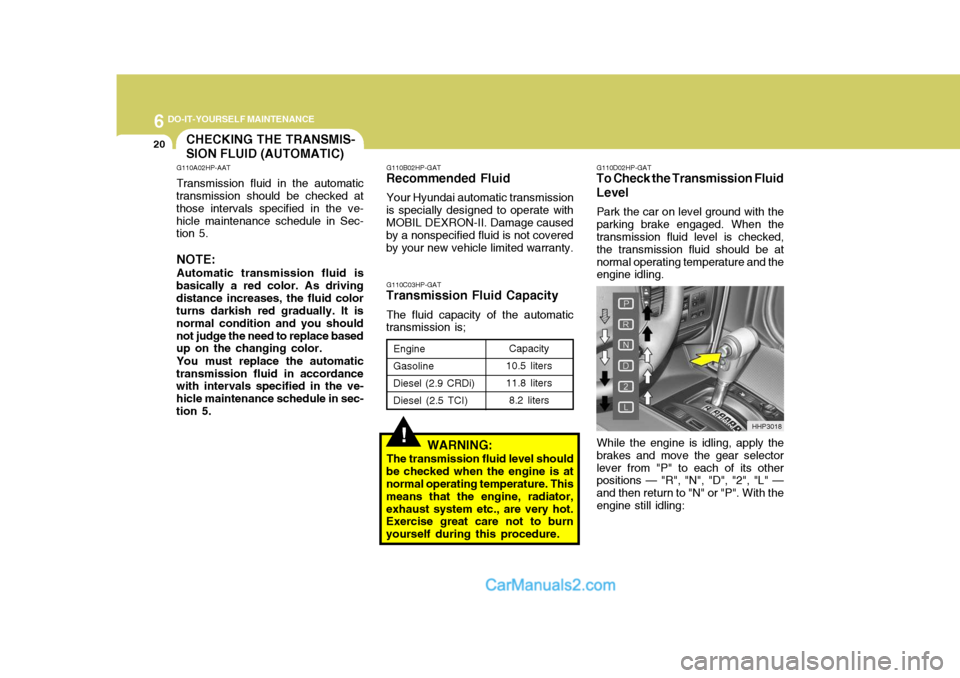
6 DO-IT-YOURSELF MAINTENANCE
20CHECKING THE TRANSMIS- SION FLUID (AUTOMATIC)
!
G110B02HP-GAT
Recommended Fluid
Your Hyundai automatic transmission
is specially designed to operate with MOBIL DEXRON-II. Damage caused by a nonspecified fluid is not coveredby your new vehicle limited warranty.
G110C03HP-GAT
Transmission Fluid Capacity
The fluid capacity of the automatic
transmission is;
WARNING:
The transmission fluid level should
be checked when the engine is at normal operating temperature. This means that the engine, radiator,exhaust system etc., are very hot. Exercise great care not to burn yourself during this procedure. G110D02HP-GAT
To Check the Transmission Fluid Level
Park the car on level ground with the parking brake engaged. When the transmission fluid level is checked, the transmission fluid should be atnormal operating temperature and the engine idling.
While the engine is idling, apply the
brakes and move the gear selector lever from "P" to each of its other positions — "R", "N", "D", "2", "L" — and then return to "N" or "P". With theengine still idling:
G110A02HP-AAT Transmission fluid in the automatic
transmission should be checked at those intervals specified in the ve-hicle maintenance schedule in Sec- tion 5.
NOTE: Automatic transmission fluid is
basically a red color. As driving distance increases, the fluid color turns darkish red gradually. It is normal condition and you shouldnot judge the need to replace based up on the changing color.
You must replace the automatic
transmission fluid in accordancewith intervals specified in the ve- hicle maintenance schedule in sec-tion 5.
Engine GasolineDiesel (2.9 CRDi)Diesel (2.5 TCI) Capacity
10.5 liters11.8 liters 8.2 liters
HHP3018
Page 244 of 539
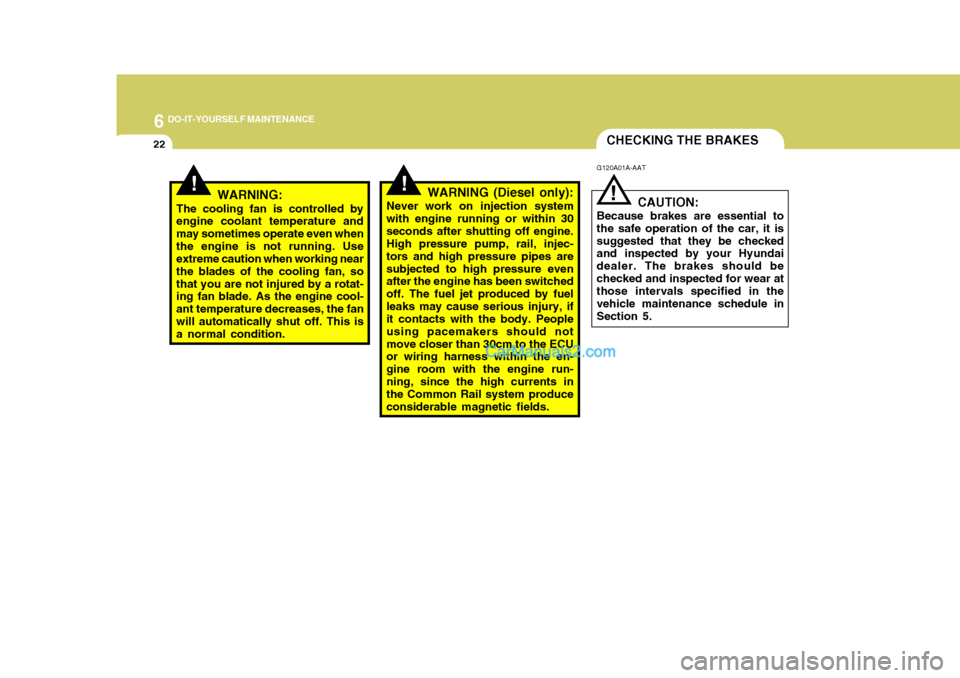
6 DO-IT-YOURSELF MAINTENANCE
22CHECKING THE BRAKES
!
G120A01A-AAT
CAUTION:
Because brakes are essential to the safe operation of the car, it issuggested that they be checked and inspected by your Hyundai dealer. The brakes should bechecked and inspected for wear at those intervals specified in the vehicle maintenance schedule inSection 5.!!WARNING:
The cooling fan is controlled by engine coolant temperature and may sometimes operate even whenthe engine is not running. Use extreme caution when working near the blades of the cooling fan, sothat you are not injured by a rotat- ing fan blade. As the engine cool- ant temperature decreases, the fanwill automatically shut off. This is a normal condition. WARNING (Diesel only):
Never work on injection system
with engine running or within 30 seconds after shutting off engine. High pressure pump, rail, injec- tors and high pressure pipes aresubjected to high pressure even after the engine has been switched off. The fuel jet produced by fuelleaks may cause serious injury, if it contacts with the body. People using pacemakers should notmove closer than 30cm to the ECU or wiring harness within the en- gine room with the engine run-ning, since the high currents in the Common Rail system produce considerable magnetic fields.
Page 245 of 539
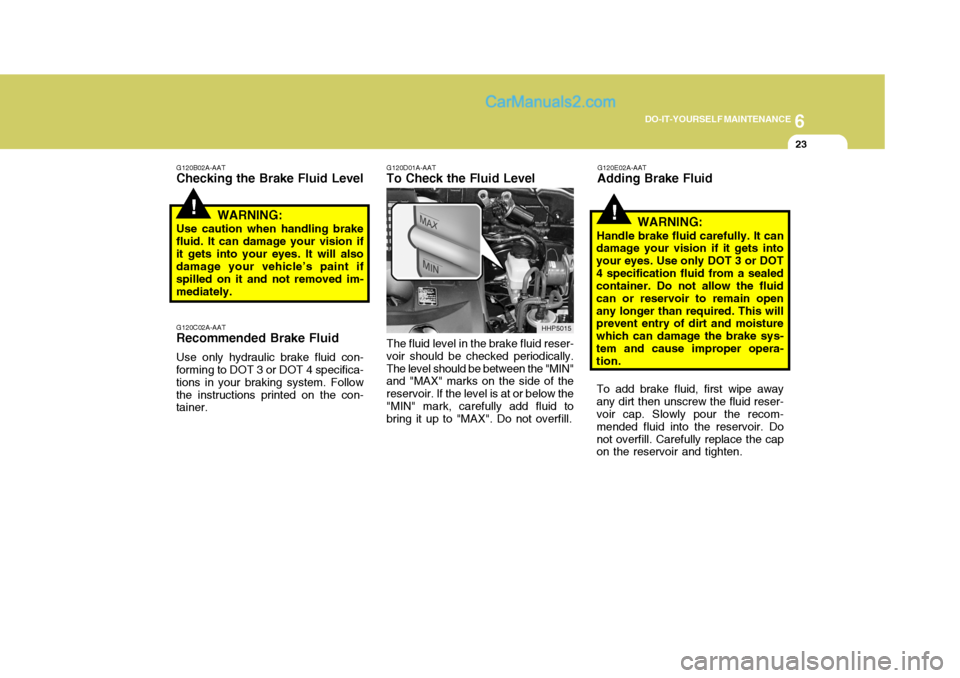
6
DO-IT-YOURSELF MAINTENANCE
23
!
G120B02A-AAT
Checking the Brake Fluid Level
WARNING:
Use caution when handling brake
fluid. It can damage your vision if it gets into your eyes. It will also damage your vehicle’s paint if spilled on it and not removed im-mediately.
G120C02A-AAT
Recommended Brake Fluid
Use only hydraulic brake fluid con-
forming to DOT 3 or DOT 4 specifica-tions in your braking system. Followthe instructions printed on the con- tainer. G120D01A-AAT
To Check the Fluid Level
The fluid level in the brake fluid reser-
voir should be checked periodically. The level should be between the "MIN" and "MAX" marks on the side of the reservoir. If the level is at or below the"MIN" mark, carefully add fluid to bring it up to "MAX". Do not overfill. HHP5015
!
G120E02A-AAT
Adding Brake Fluid
WARNING:
Handle brake fluid carefully. It can
damage your vision if it gets into your eyes. Use only DOT 3 or DOT4 specification fluid from a sealed container. Do not allow the fluid can or reservoir to remain openany longer than required. This will prevent entry of dirt and moisture which can damage the brake sys-tem and cause improper opera- tion.
To add brake fluid, first wipe away any dirt then unscrew the fluid reser- voir cap. Slowly pour the recom- mended fluid into the reservoir. Donot overfill. Carefully replace the cap on the reservoir and tighten.
Page 246 of 539
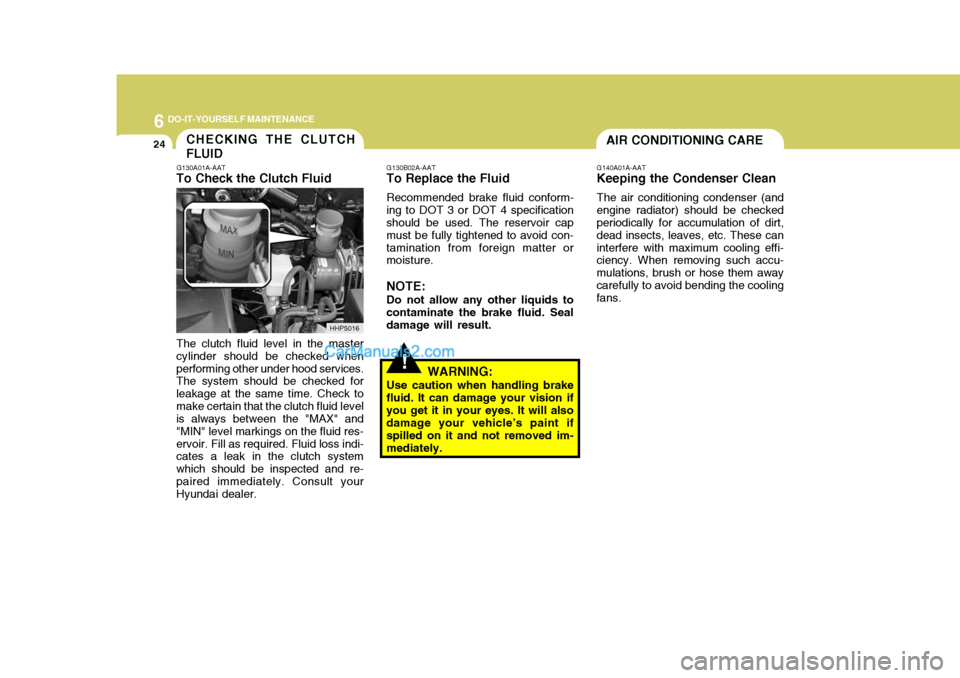
6 DO-IT-YOURSELF MAINTENANCE
24AIR CONDITIONING CARECHECKING THE CLUTCH FLUID
G140A01A-AAT
Keeping the Condenser Clean
The air conditioning condenser (and
engine radiator) should be checked periodically for accumulation of dirt, dead insects, leaves, etc. These caninterfere with maximum cooling effi- ciency. When removing such accu- mulations, brush or hose them awaycarefully to avoid bending the cooling fans.
!
G130A01A-AAT
To Check the Clutch Fluid The clutch fluid level in the master cylinder should be checked whenperforming other under hood services. The system should be checked for leakage at the same time. Check tomake certain that the clutch fluid level is always between the "MAX" and "MIN" level markings on the fluid res-ervoir. Fill as required. Fluid loss indi- cates a leak in the clutch system which should be inspected and re-paired immediately. Consult your Hyundai dealer. G130B02A-AAT
To Replace the Fluid
Recommended brake fluid conform-
ing to DOT 3 or DOT 4 specificationshould be used. The reservoir cap must be fully tightened to avoid con-tamination from foreign matter or moisture.
NOTE: Do not allow any other liquids to
contaminate the brake fluid. Seal damage will result.
WARNING:
Use caution when handling brake
fluid. It can damage your vision ifyou get it in your eyes. It will also damage your vehicle’s paint if spilled on it and not removed im-mediately.
HHP5016
Page 252 of 539
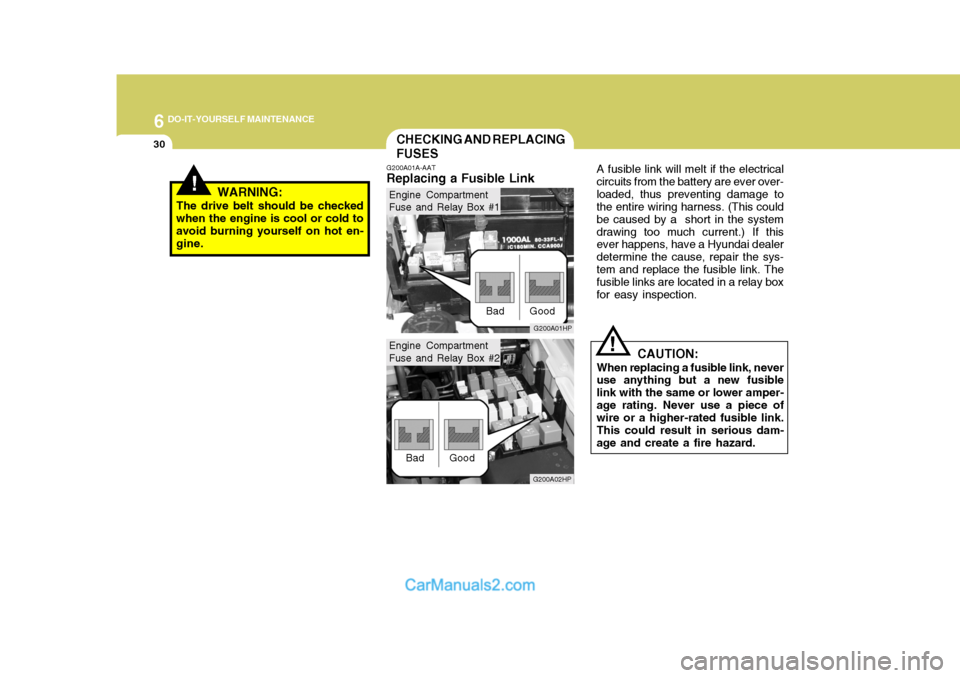
6 DO-IT-YOURSELF MAINTENANCE
30CHECKING AND REPLACING FUSES
!
G200A01A-AAT
Replacing a Fusible Link A fusible link will melt if the electrical
circuits from the battery are ever over- loaded, thus preventing damage to the entire wiring harness. (This could be caused by a short in the systemdrawing too much current.) If this ever happens, have a Hyundai dealer determine the cause, repair the sys-tem and replace the fusible link. The fusible links are located in a relay box for easy inspection.
CAUTION:
When replacing a fusible link, never use anything but a new fusible link with the same or lower amper-age rating. Never use a piece of wire or a higher-rated fusible link. This could result in serious dam-age and create a fire hazard.
G200A01HP
G200A02HP
!WARNING:
The drive belt should be checked when the engine is cool or cold to avoid burning yourself on hot en- gine.
Bad GoodBad GoodEngine Compartment Fuse and Relay Box #1
Engine Compartment Fuse and Relay Box #2
Page 254 of 539
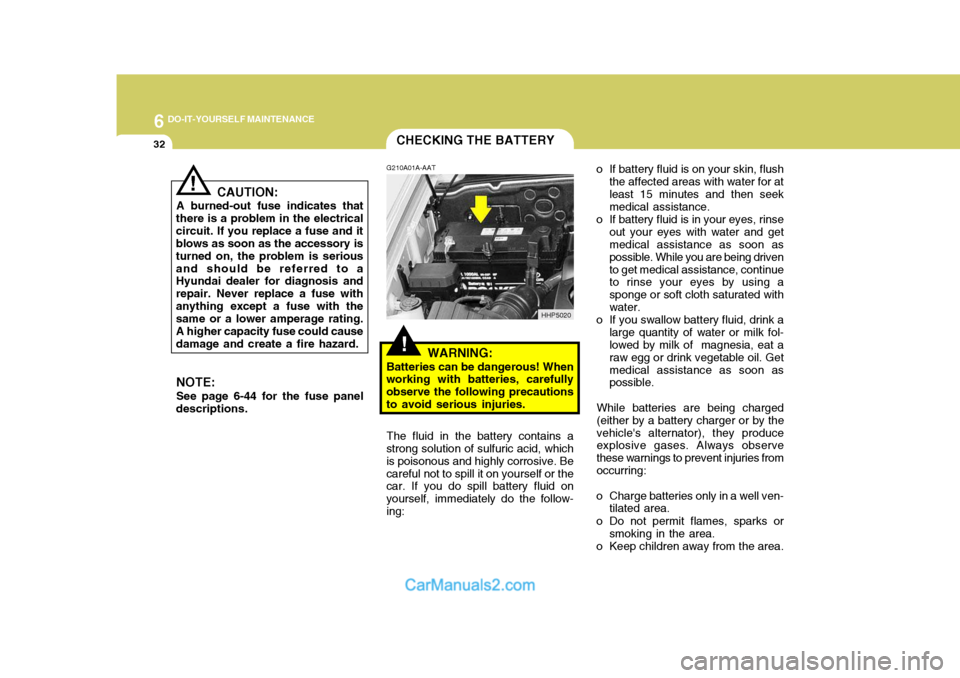
6 DO-IT-YOURSELF MAINTENANCE
32CHECKING THE BATTERY
!
G210A01A-AAT
WARNING:
Batteries can be dangerous! When
working with batteries, carefully observe the following precautionsto avoid serious injuries. o If battery fluid is on your skin, flush
the affected areas with water for atleast 15 minutes and then seek medical assistance.
o If battery fluid is in your eyes, rinse out your eyes with water and getmedical assistance as soon as possible. While you are being drivento get medical assistance, continue to rinse your eyes by using a sponge or soft cloth saturated withwater.
o If you swallow battery fluid, drink a large quantity of water or milk fol- lowed by milk of magnesia, eat a raw egg or drink vegetable oil. Getmedical assistance as soon as possible.
While batteries are being charged (either by a battery charger or by thevehicle's alternator), they produce explosive gases. Always observe these warnings to prevent injuries fromoccurring:
o Charge batteries only in a well ven- tilated area.
o Do not permit flames, sparks or smoking in the area.
o Keep children away from the area.
The fluid in the battery contains a
strong solution of sulfuric acid, whichis poisonous and highly corrosive. Becareful not to spill it on yourself or the car. If you do spill battery fluid on yourself, immediately do the follow-ing:
CAUTION:
A burned-out fuse indicates that
there is a problem in the electricalcircuit. If you replace a fuse and it blows as soon as the accessory is turned on, the problem is seriousand should be referred to a Hyundai dealer for diagnosis and repair. Never replace a fuse withanything except a fuse with the same or a lower amperage rating. A higher capacity fuse could causedamage and create a fire hazard.
NOTE: See page 6-44 for the fuse panel
descriptions.
!
HHP5020
Page 255 of 539
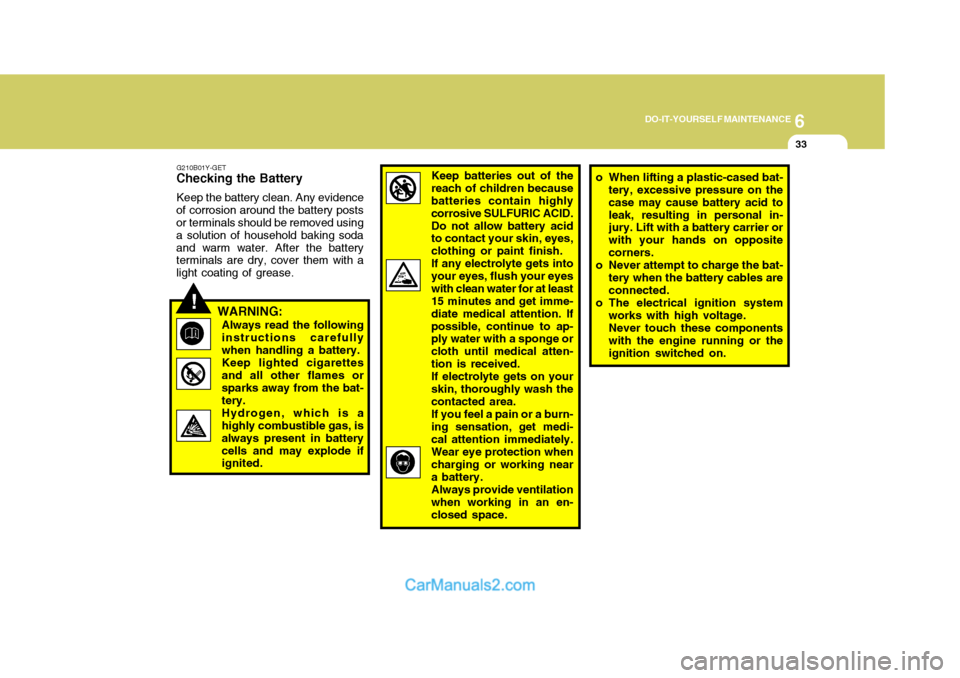
6
DO-IT-YOURSELF MAINTENANCE
33
!
G210B01Y-GET
Checking the Battery
Keep the battery clean. Any evidence
of corrosion around the battery posts or terminals should be removed using a solution of household baking sodaand warm water. After the battery terminals are dry, cover them with a light coating of grease.
WARNING:Always read the followinginstructions carefullywhen handling a battery.Keep lighted cigarettesand all other flames orsparks away from the bat- tery. Hydrogen, which is a highly combustible gas, is always present in batterycells and may explode if ignited.Keep batteries out of the reach of children because batteries contain highly corrosive SULFURIC ACID.Do not allow battery acid to contact your skin, eyes, clothing or paint finish.If any electrolyte gets intoyour eyes, flush your eyeswith clean water for at least 15 minutes and get imme- diate medical attention. Ifpossible, continue to ap- ply water with a sponge or cloth until medical atten-tion is received.If electrolyte gets on yourskin, thoroughly wash thecontacted area.If you feel a pain or a burn-ing sensation, get medi- cal attention immediately. Wear eye protection when charging or working near a battery. Always provide ventilation when working in an en- closed space.o When lifting a plastic-cased bat- tery, excessive pressure on the case may cause battery acid toleak, resulting in personal in- jury. Lift with a battery carrier or with your hands on oppositecorners.
o Never attempt to charge the bat- tery when the battery cables are connected.
o The electrical ignition system works with high voltage. Never touch these componentswith the engine running or the ignition switched on.
Page 256 of 539

6 DO-IT-YOURSELF MAINTENANCE
34
Gasoline Engine or Diesel Engine (2.5 TCI)
POWER STEERING FLUID LEVEL
G220B01A-AAT
Checking Engine Cooling Fan
The engine cooling fan should come
on automatically if the engine coolant temperature is high.
G220C01A-AAT
Checking Condenser Cooling Fan
The condenser cooling fan should
come on automatically whenever the air conditioning is in operation. G230A03A-AAT The power steering fluid level should
be checked daily. G230A01HP
HHP5014CHECKING ELECTRIC COOLING FANS
!
G220A01A-AAT WARNING:
The cooling fan is controlled by engine coolant temperature and may sometimes operate even whenthe engine is not running. Use extreme caution when working near the blades of the cooling fan,so that you are not injured by a rotating fan blade. As the engine coolant temperature decreases thefan will automatically shut off. This is a normal condition.
Diesel Engine (2.9 CRDi)